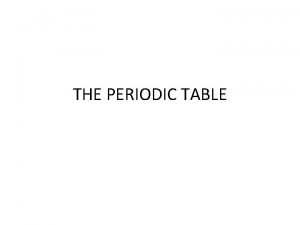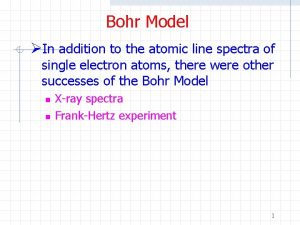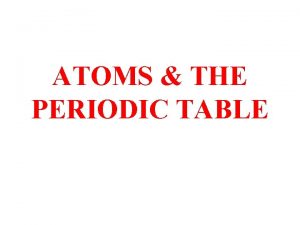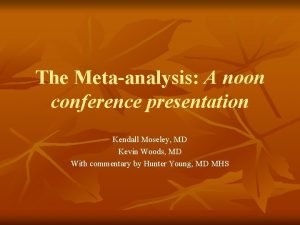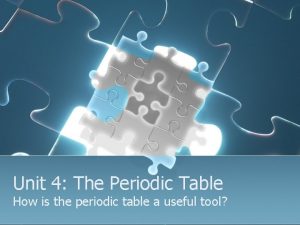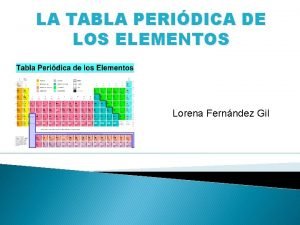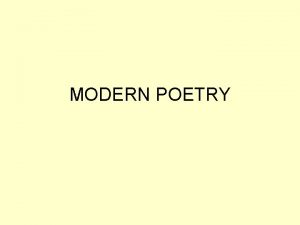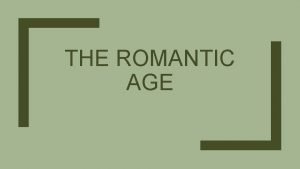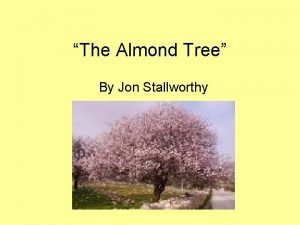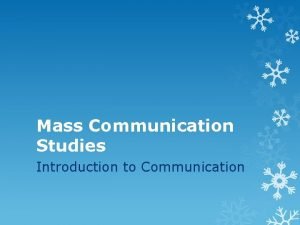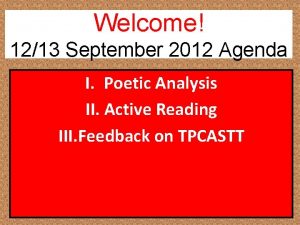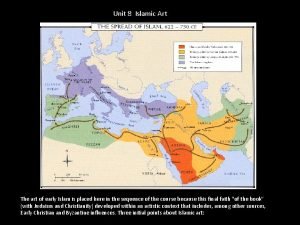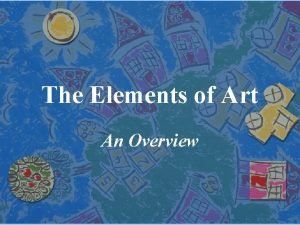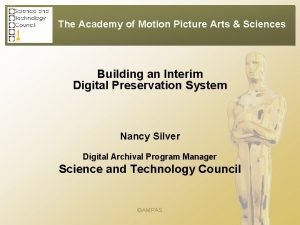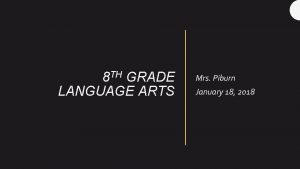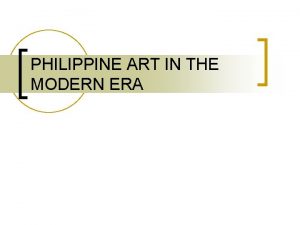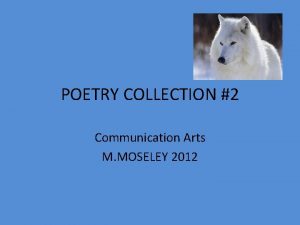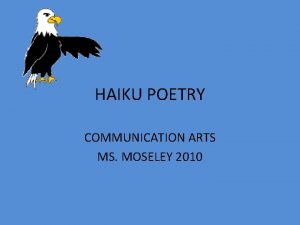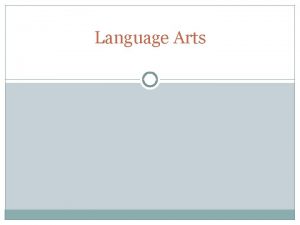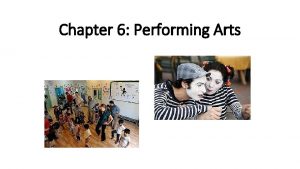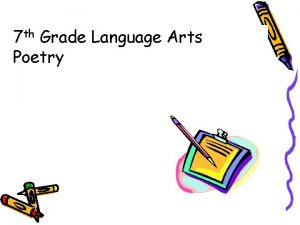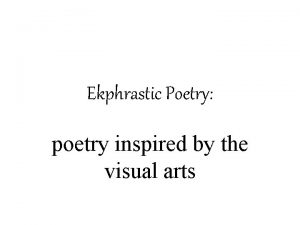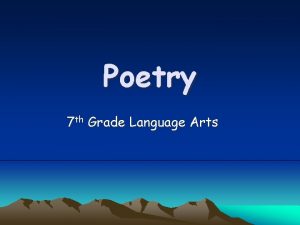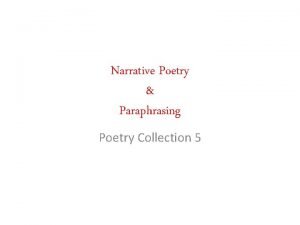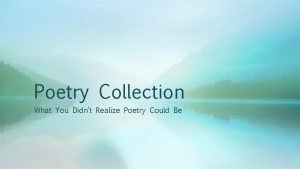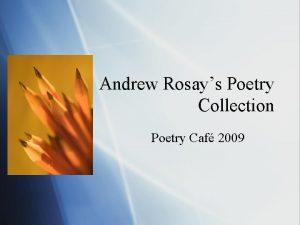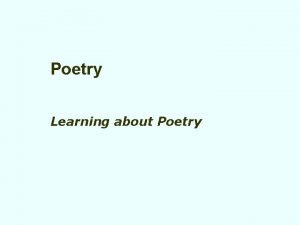POETRY COLLECTION 1 Communication Arts MS Moseley POETRY










































- Slides: 42

POETRY COLLECTION #1 Communication Arts MS. Moseley

POETRY 1) POETRY – Imaginative writing in which language, images, sound, and rhythm combine to create a special emotional effect. Poetry is usually arranged in lines and stanzas.

WHEN THE FROST IS ON THE PUNKIN BY: James Whitcomb Riley

When the frost is on the punkin and the fodder’s in the shock, And you hear the kyouck and gobble of the struttin’ turkey cock, And the clackin’ of the guineys and the cluckin’ of the hens, And the rooster’s hallylooyer as he tiptoes on the fence;

O, it’s then’s the time a feller is a-feelin’ at his best, With the risin’ sun to greet him from a night of peaceful rest, As he leaves the house, bareheaded, and goes out to feed the stock, When the frost is on the punkin and the fodder’s in the shock.

They’s something kindo’ harty-like about the atmusfere When the heat of summer’s over and the coolin’ fall is here---Of course we miss the flowers, and the blossums on the trees, And the mumble of the hummin’birds and buzzin’ of the bees;

But the air’s so appetizin’; and the landscape through the haze Of a crisp and sunny morning of the airly autumn days Is a pictur’ that no painter has the colorin’ to mock---When the frost is on the punkin and the fodder’s in the shock.

The husky, rusty russel of the tossels of the corn, And the raspin’ of the tangled leaves, as golden as the morn; The stubble in the furries ---- kindo’ lonesome-like, but still A-preachin’ sermuns to us of the barns they growed to fill;

The strawstack in the medder, and the reaper in the shed; The hosses in theyr stalls below ---- the cloverhead! ---O, it sets my hart a-clickin’ like the tickin’ of a clock, When the frost is on the punkin and the fodder’s in the shock!

Then your apples all is gethered, and the ones a feller keeps Is poured around the cellar floor in red and yeller heaps; And your cider makin’s over, and your wimmern folks is through With theyr mince and apple butter, and theyr souse and sausage, too!

I don’t know how to tell it ---- but ef sich a thing could be As the Angels wantin’ boardin’, and they’d call around on me---I’d want to ‘commodate ‘em ---- all the whole indurin’ flock ---When the frost is on the punkin and the fodder’s in the shock!

2 - DIALECT • Dialect is the special form of speech that belongs to a particular group or region. • It is a variation of a language. • A dialect uses some vocabulary that differs from that of standard English.

EXAMPLE • A large sandwich made on a long tube roll may be called a: Submarine, a zeppelin, a grinder, or a hoagie, depending on the part of the country in which you live.

DIALECT • A dialect may also play with the spellings of standard English as well as with their sounds, forms, and meanings. • punkin – pumpkin • kyouck – cluck • guineys – guineas • kindo’ – kind of • harty-like – hearty like

DIALECT • atmusphere – atmosphere • yeller – yellow • hallylooyer – hallelujah

WORD CHOICE • Poets must be especially careful about using exactly the right words. • Poetry tries to say a great deal in just a few words. • A poet may choose a particular word for a variety of reasons. • For instance, the word may rhyme with another word, or its sound may echo its sense.

WORD CHOICE • A word may add a double meaning or a tricky twist to the poem. • It may also create a vivid picture or highlight a certain emotion.

SMELLS Why is it that the poets tell So little of the sense of smell? These are the odors I love well; The smell of coffee freshly ground; Or rich plum pudding, holly-crowned; Or onions fried and deeply browned.

The fragrance of a fumy pipe; The smell of apples, newly ripe; And printer’s ink on leaden type. Woods by moonlight in September Breathe most sweet; and I remember Many a smoky campfire ember.

Camphor, turpentine, and tea, The balsam of a Christmas tree, These are whiffs of grammrye. . . A sip smells best of all to me! By: Christopher Morley This poem is a great example of 3 - IMAGERY – Language that appeals to the senses. 4 – IMAGE – A picture or likeness that a poet creates with words.

SMELLS This poem has good examples of 5 - RHYME – The repetition of sounds at the end of words. This poem has several 6 - END RHYMES – Rhymes in which rhyming words come at the end of a line in a poem. This poem does not have any 7 - INTERNAL RHYMES – Rhymes in which rhyming words come in the middle of a line of poetry.

BUFFALO DUSK The buffaloes are gone. And those who saw the buffaloes are gone. Those who saw the buffaloes by thousands and how they pawed The prairie sod into dust with their hoofs, their great heads Down pawing on in a great pageant of dusk, Those who saw the buffaloes are gone. And the buffaloes are gone.

This poem has a great use of 8 - REPETITION – The repeated use of sounds, words, phrases, or lines.

TRAIN TUNE Back through clouds Back through clearing Back through distance Back through silence Back through groves Back through garlands Back by rivers Back through mountains

Back through lightening Back through cities Back through stars Back through hours Back through plains Back through flowers Back through birds Back through rain

Back through smoke Back through noon Back through love Back through midnight By: Louise Bogan This poem is a great example of 9) RHYTHM - a pattern of stressed and unstressed syllables in a line of poetry and 10) METER – the regular pattern of stressed and unstressed syllables. Although most poems have a rhythm, not all poems have a meter.

VOYAGE I was the fourth ship Behind Nina, Pinta, and Santa Maria, Lost at sea while watching a seagull, Following the wind and sunset skies, While others set their charts.

I was the fourth ship. Breathing in salt and flying with clouds, Sailing moonbreezes and starvision nights, Rolling into the wave and savoring its lull, While the others pointed their prows.

I was the fourth ship. Playfully in love with the sea, Eternally entwined with the sky, Forever vowed to my voyage, While the others shouted “Land. ” By: Carmen Tafolla 11 - STANZAS – Poetry is often arranged in these groups of lines called stanzas. 12 - FREE VERSE – Poetry without regular patterns of rhyme and rhythm is called free verse.

SEAGULLS Between the under and the upper blue All day the seagulls climb and swerve and soar, Arc intersecting arc, curve over curve. And you may watch them weaving a long time And never see their pattern twice the same And never see their pattern once imperfect.

Take any moment they are in the air---If you could change them, if you had the power How would you place them other than they are? What we have labored all our lives to have And failed, these birds effortlessly achieve: Freedom that flows in form and still is free.

13 - ALLITERATION • Alliteration is a special effect of poetry. • It is the repetition of consonant sounds, most often at the beginnings of words. • All day the seagulls climb and swerve and soar • Alliteration adds to the musical quality of a poem by creating echoes among the sounds.

THE PASTURE I’m going out to clean the pasture spring; I’ll only stop to rake the leaves away (And wait to watch the water clear, I may): I sha’n’t be gone long. – You come too.

I’m going out to fetch the little calf That’s standing by the mother. It’s so young It totters when she licks it with her tongue. I sha’n’t be gone long. – You come too. BY: Robert Frost What is the 14 - RHYME SCHEME of this poem?

FOG The fog comes on little cat feet. It sits looking over harbor and city on silent haunches and then moves on.

15 - METAPHOR This poem is a good example of the use of 15 - METAPHOR – A comparison of two things that are basically unlike but have some qualities in common without using the words LIKE or AS. To what is the author comparing to FOG? ? ?

THIS LAND IS YOUR LAND Refrain This land is your land, this land is my land From California to the New York island; From the redwood forest to the Gulf Stream waters; This land was made for you and me.

As I was walking that ribbon of highway, I saw above me that endless skyway. I saw below me that golden valley, This land was made for you and me.

I’ve roamed and rambled and I followed my footsteps To the sparkling sands of her diamond deserts, And all around me a voice was sounding, “This land was made for you and me. ”

When the sun comes shining and I was strolling And the wheatfields waving and the dust clouds rolling, As the fog was lifting a voice was chanting, “This land was made for you and me. ”

16 - LYRIC POEMS • 16 - LYRIC POEM – A short poem in which a single speaker expresses personal thoughts and feelings. (Are often put to music) • Poems and songs are close cousins. * Long ago poems were not just recited; • They were often sung. • The poet’s song was accompanied by a harplike instrument. • Meaning and music were closely combined

17 - REFRAIN • Though poets no longer play music with their poems, the songlike qualities of poetry remain. • Like some songs, some poems have a 17 - REFRAIN - a line or group of lines repeated at regular intervals. • The first four lines of “This Land Is Your Land” are a refrain.
 Creative arts grade 8 term 1
Creative arts grade 8 term 1 Mendeleev e moseley
Mendeleev e moseley William moseley desnudo
William moseley desnudo Moseley law formula
Moseley law formula Henry moseley contribution to the periodic table
Henry moseley contribution to the periodic table Mendeleev moseley
Mendeleev moseley Kendall moseley
Kendall moseley La tavola periodica mappa concettuale
La tavola periodica mappa concettuale Röntgenröhre
Röntgenröhre Group vs period
Group vs period Moseley periodic law
Moseley periodic law Ley de moseley
Ley de moseleySir james chadwick atomic theory
 Landsat collection 1 vs collection 2
Landsat collection 1 vs collection 2 Documentary payment
Documentary payment Chulalongkorn university faculty of arts
Chulalongkorn university faculty of arts Cavalier poetry definition
Cavalier poetry definition Traditional poetry vs modern poetry
Traditional poetry vs modern poetry Famous lyric poems
Famous lyric poems Augustan poetry aim
Augustan poetry aim Almond trees poem
Almond trees poem Parallel serial port
Parallel serial port What is oral communication and written communication
What is oral communication and written communication Parallel and serial communication
Parallel and serial communication Mass communication
Mass communication Oral communication conclusion
Oral communication conclusion Serial communication vs parallel communication
Serial communication vs parallel communication Musee des beaux arts analysis
Musee des beaux arts analysis Extended essay visual arts
Extended essay visual arts Studio arts assessment criteria 2021
Studio arts assessment criteria 2021 Khurasan
Khurasan Martial arts in malay
Martial arts in malay Torquay theatre troupe
Torquay theatre troupe A consistent, orderly or pleasing arrangement of parts
A consistent, orderly or pleasing arrangement of parts Kyiv national university of culture and arts
Kyiv national university of culture and arts Elements of art
Elements of art Academy of motion picture arts and sciences benefits
Academy of motion picture arts and sciences benefits Language arts
Language arts Queens college thanjavur
Queens college thanjavur Queens arts and science
Queens arts and science Shanghai by roberto chabet
Shanghai by roberto chabet Which characteristic of
Which characteristic of Monash university exchange program
Monash university exchange program

